Tea in China 茶
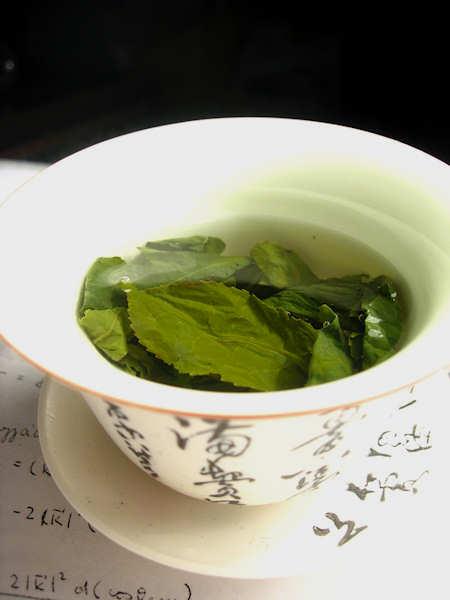
“For all the tea in China” is an English idiom for an overwhelming abundance. China has been at the heart of the development of the global tea industry for thousands of years.
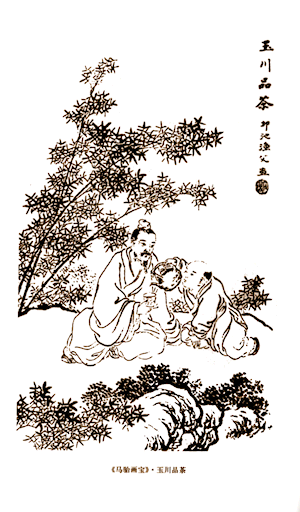
Image available under a Creative Commons license ➚
History of Chinese Tea drinking
Tea drinking may have been established as long ago as 3,000 years ago in the Zhou dynasty. According to legend it was the Emperor Shennong who introduced the drink when a leaf by chance fell into a cup of hot water. However it is difficult to be sure whether the infusion was of what we now know as 'tea' or some other herb. It seems to have originated from the hills of Sichuan, Yunnan and Guizhou provinces. In Yunnan some ancient tea trees can grow to 30 feet [9 meters] and are believed to live to 3,000 years. It's initial use was as a medicine, the legend has it that the very bitter tasting leaf accidentally ended up in Shennong's cup and he felt much better for it. Tea became popular in China at the same time as Buddhism – 1,800 years ago. Buddhist monks found it useful as a stimulant to keep alert during long meditations and one Buddhist tradition has the origin of tea coming from the eyebrows of Buddha. Soon it was cultivated widely in Sichuan and south of the Yangzi.
At this time the leaves were not processed they were just picked off the tree and boiling water poured on them. Actually it is the use of boiled water that adds greatly to its health properties - cold water harbors all sorts of pests and diseases. There remains a reluctance to drink cold water in China as it is considered unhealthy. By the Tang dynasty the demand was such that the government imposed control over the trade. At this time the tea was steamed before use so much of the bitterness was lost. Books were written about tea: Lu Yu's Cha Jing ➚ (c. 770CE) details amongst many other things which are the best colored porcelain for tea cups to show off the color of the tea. It details the Chinese tea ritual complete with the 24 special instruments you need to make a brew correctly. Some of the suggested additional ingredients include orange peel, salt and slices of onion. The classic also describes the cultivation of the plant and the best time of day and weather to pick the leaves. The source of the water should be pure, and certain places became famous for their water for tea-making, for example 虎跑梦泉 Hǔ pǎo quán ‘Running tiger Spring’ near Hangzhou.
Tea plants need exacting requirements to flourish: good drainage, moist air, sunlight (but not too much) and rich loamy soil.
For many centuries tea competitions (斗茶 dòu chá) were held to identify the best tea of the year. When southern China was colonized the northern Chinese took their addiction to tea with them. The demand for tea grew in neighboring areas: Tibet, Russia and Japan. An ancient trading route - the Tea Horse Road opened up taking tea from Yunnan to Lhasa in Tibet and then on into India. Tibetans consumed their tea as a buttered 'brick' of wet leaves. In the Song dynasty the brick tea was replaced by dried leaves, some was prepared as a fine dust which was whisked with water to form a froth of tea ➚ rather than an infusion.
Later on the Chinese tea trade was suppressed in the Yuan dynasty, as the Mongols saw tea drinking as decadent, but was restored as soon as the Ming dynasty came to power. During the Ming the harvested tea leaves began to be dried rather than steamed producing dry leaves rather than an oily block. White tea made from the youngest buds became the most prized but a great many new varieties competed for a burgeoning market.

The well-known Japanese tea ceremony ➚ came into prominence in the Tokugawa shogunate (1615-1868), when Japanese women were trained to carry out the elaborate steps provide of tea for guests. The story is that tea drinking was introduced by a Buddhist priest from China and the strict rituals of the ceremony come from that origin. The elaborate Japanese tea ceremony is known as 茶道 chá dào in China. In Southern China the 工夫茶 Gōng fu chá tea ceremony is equally elaborate.
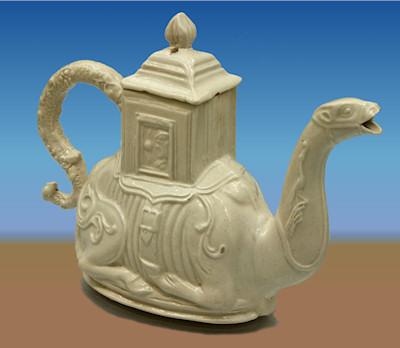
Image by Valerie McGlinchey available under a Creative Commons license ➚
Cha is the Chinese word for tea 茶 chá from whence the English word 'char' ➚ is derived. The English word ‘tea’ comes from the local Fujian dialect which pronounces 茶 as ‘ti’. The character is a pictograph of a tree under a lid - suggesting drying and oxidation, the grass radical on top indicates its plant origin. Over centuries of cultivation many other characters were introduced relating to tea, 茗 míng is a term for the young leaves; 蔎 shè and 荈 chuǎn for coarse teas.
Big Red Robe tea
One of the most prized teas in China is 大红袍 Dà hóng páo a very expensive Oolong tea grown in the Wuyi mountains, Fujian. One particularly exposed, high location known as 九龙窠 Jiǔ lóng kē 'Nine dragon nest' was where it had its origin. Legend has it that nine dragons fought over the area and were turned into stone to form the high karst peaks of the area. The story of the origin of the tea has it that an exhausted and unwell student was quickly cured by the brew and graduated as the top jinshi scholar in the examinations. The emperor heard about and when it cured the empress from illness he was extremely grateful. The emperor sent a red silk robe to act as a blanket to protect the tea bush roots from frost and this gave the name to the tea. The first pickings of these bushes was sent to the Emperor each year from then on. Originally there were just three bushes which were two hundred years old and maintained by Buddhist monks. The British plant-hunter Robert Fortune took seedlings and seed from the plants and these formed the foundation for the Indian tea industry at Darjeeling. In 1972 Mao Zedong gave a present of this precious tea to President Richard Nixon on his historic visit.
The Tea trade
Tea came to be the most important Chinese export once the Europeans had acquired a taste for it. It was the Dutch who started the trade at the start of the 17th century. It was initially so expensive that only the very wealthy could afford it. The taste for tea in Britain probably came with Catherine of Braganza ➚ (1638-1705), the Portuguese wife of King Charles II. She knew of the exotic beverage that was exported in small quantities from Macau. Tea caddies ➚ of this early period had a lock to protect the expensive leaves from theft. The word ‘caddie’ is derived from ‘catty’ the standard measure for weight of tea. A catty of tea weighs about 1 pound [600 grams]. Along with bolts of silk and silver, catties of tea were used as a currency; gifts to China's neighboring kingdoms was partly made with catties of tea.
“That excellent and by all Physicians approved, China Drink, Called by the Chineans Tcha, by other Nations Tay alias Tee”,
London Weekly News 21st January 1606.
Peter Mundy, one of the first Englishmen to visit China, wrote in his journal in 1637:
“Chaa, what it is: The people there gave us a certaine Drinke called Chaa, which is only water with a kind of herbe boyled in itt. It must bee Drancke warmed and is accompted wholesome.”
Centuries on and more countries began to take a liking to the infusion. Originally nearly all the exported tea came from the relatively small province of Fujian whose mountainous climate is ideally suited to growing the shrub. As Fujian is a coastal province, transport to Europe was easy by sea with the famous tea clippers ➚ vying to make the fastest journey to Europe with the new, fresh harvest. Some customers preferred the taste of the tea carried overland on the Silk Road, it is believed this was because the sweat of the camels contributed to the taste.
As green (unprocessed) tea does not keep its delicate flavor for long it was the black tea that has been oxidized that was generally exported. Black tea is slightly bitter and so sugar and milk were used to mellow the flavor. Some tea was exported to Russia but most went to Britain, and it was the British East India Company ➚ that handled the shipping. Trade increased 50 fold in just 80 years as ordinary people now got a taste for it . By the late eighteenth century tea accounted for more than 60% of the East India Company’s trade. It was the huge demand for tea that proved the stimulus for the Opium Wars as China wanted silver in payment for the tea; the trade would have been much more profitable if the tea ships could take merchandise to China in exchange for it. China was very keen to keep its monopoly and keep the exact processes secret. To break the Chinese monopoly in tea cultivation the company started growing tea in the Assam district of northern India. It is said that the ill-fated Macartney expedition to China (1793) brought back tea plants from China to the botanic gardens at Kolkata (Calcutta) from these few plants the Indian tea industry may have developed. However it was the careful spying operation of Robert Fortune ➚ (1840s) that revealed not only how to cultivate the plant but also to process the tea that was the breakthrough.
Fortune led two main expeditions (1848-49) to collect tea in China for transplantation to British northern India where the Himalayan foothills offer a similar climate to Fujian. There were native tea plants in Assam but they produced teas too bitter to drink. The breakthrough came in the second shipment of 15,000 plants and seeds in sealed Ward cases. These cases allowed plants to grow during the lengthy transportation by sea and land which would kill anything open to the heat and humidity of tropical India. Fortune also settled the long held view that green and black teas came from different species of tea. He found that although different areas produced the green and black teas the real difference was in the processing. As the tea industry was at the time a state secret, like porcelain manufacture, Fortune went around disguised as a government official from some far away province. He managed to escape detection and from the East India Company's base at Shanghai recruited tea experts for service at the plantations at Darjeeling, India. The hugely profitable tea industry also helped the sales of sugar. Their expertise was essential as the processing of tea leaves is very complex requiring great care. Soon enough the teas from Darjeeling became the must have teas in the world.
In order to promote Indian rather than Chinese tea a story came out that all tea originally came from India not China; from then on most of the tea drunk in Britain came from northern India and Sri Lanka rather than China. China also suffered from a discovery made by Robert Fortune, to give the tea a strong green color required by consumers some tea in China had poisonous Prussian Blue and heated gypsum added. Thomas Lipton ➚ pioneered the cultivation of tea in Sri Lanka for export to the US.
Porcelain tea sets produced in China became the must have items for tea drinking in Europe. The styles used for export were very different from those used domestically in China.
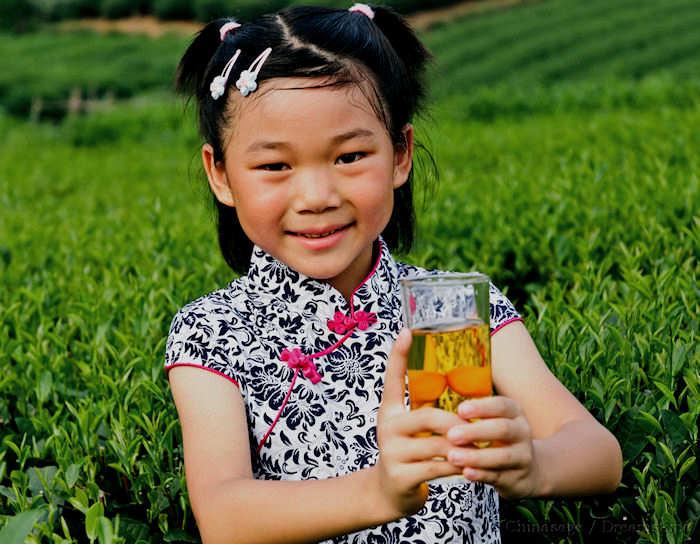
Cultivating Tea
Camellia sinensissinensis (‘Sinensis’ means from China) is the Latin name for the tea plant. The small tree is in the same family as the ornamental Camellia which flowers in Spring. It is kept as a low shrub by pruning. The variety grown in China is the smaller leaved version Camellia sinensis sinensis, while India grows Camellia sinensis assamica. It is the active growing tip that has the lighter and best flavor, usually just the tip and two leaves are picked. Up to five pickings can be collected in one year as the tips rapidly re-grow. The first picking in April is considered the best. Caffeine is the active stimulant that accumulates in the leaves. The foliage's bitter taste keeps away herbivores including goats. In mountainous Fujian goats are used to keep the tea terraces free from weeds as they'll eat everything except the tea plants. The plant grows best in humid conditions, and the moisture off the South China Sea makes Fujian an ideal spot to grow it. The tea plant has fragrant flowers but these are picked off so all the plant's energy goes into producing foliage. Other favored locations include the moist mountains of Sichuan; Jiangxi and Anhui.
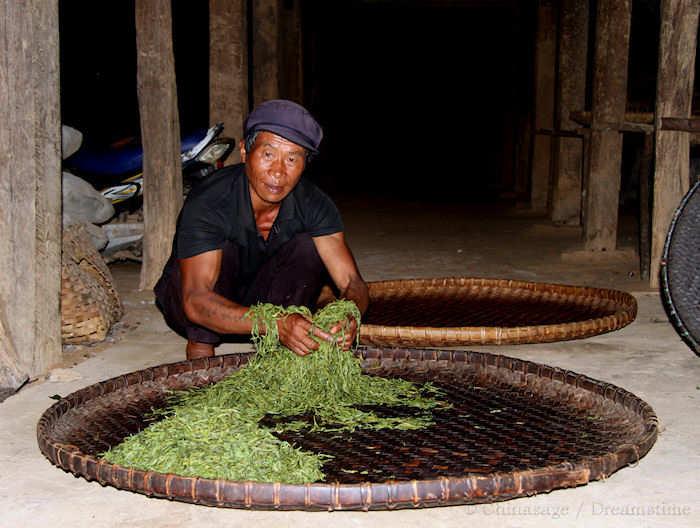
The drink of tea, particularly green tea, is high in anti-oxidants and so has anti-cancer potential as well as lowering cholesterol. There are various categories of tea ➚, green tea is the type that is unprocessed, it is just the fresh dried leaves. In contrast black (or red) tea is oxidized (often misleadingly called 'fermented') and this is the variety generally exported. The length of time that the tea is left to oxidize after picking determines the bitterness introduced. Oolong teas are intermediate in type between green and red. Chinese people usually drink green tea while black tea is drunk elsewhere in the world. This is partly because black tea holds its flavor longer which was essential for transportation on the long sea trips to Europe.
In Mongolia and Tibet tea is added into 'soups' with other ingredients and eaten rather than drunk. 'Yunnan brick tea' is a black tea mixed by the Tibetans with yak butter to produce a creamy strong tea.
Chinese Teas
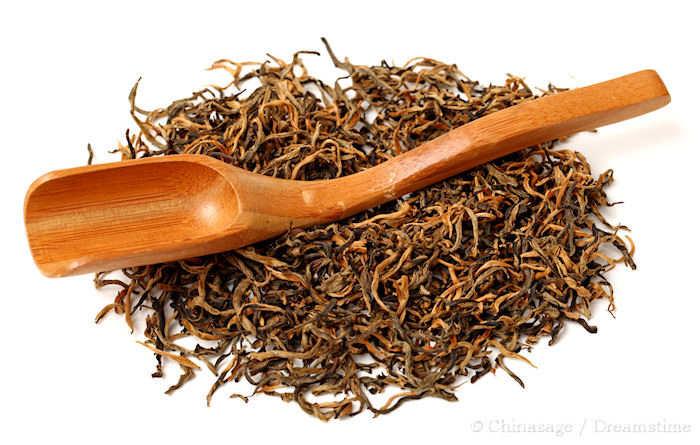
A fine tea in China commands a high price, it is not unusual to pay a $100 for 1 pound [ kgs] of tea. The appreciation of tea is very much like how wine is prized and valued in France. In rare cases it is a particular day's clippings from a particular tea plant that are most prized. In order to achieve fame individual villages produced their own variants of the processing of tea to give their tea a particular flavor. In some cases a bud and a leaf are used, in others two leaves. Pu-erh tea ➚ from Yunnan became a craze in the 1990s. In this case the tea may improve with age and so vintage teas can acquire very high prices, it only came into being in the 1960s. It is another 'black tea' different from the normal exported form.
Here are some famous teas:
| Green tea | 西湖龙井 Dragon well | Hangzhou, Zhejiang |
| Green tea | 洞庭碧螺春 Dongding Green Spiral | Suzhou, Zhejiang |
| Green tea | 黄山毛峰 Yellow mountain tip | Huangshan, Anhui |
| Green tea | 珠茶 Gunpowder | Pingshui, Zhejiang |
| Green tea | 六安瓜片 Liuan leaf | Jinzhai, Anhui |
| Green tea | 珍眉 Chun Mee | Zhejiang; Anhui |
| Oolong tea | 武夷岩茶Wuyi Rock Tea | Wuyi, Fujian |
| Oolong tea | 安溪铁观音 Anxi Iron Goddess | Anxi, Fujian |
| Yellow tea | 君山银针 Jun mountain Silver needle | Yueyang, Hunan |
| Black tea | 祁门红茶 Keemun | Qimen, Anhui |
| Black tea | 拉普山小种 Lapsang Souchong | Wuyi, Fujian |
| Black tea | Szechwan Imperial | Sichuan |
| White tea | 白毫银针 White Tip silver needle | Fuding, Fujian |
| White tea | 白牡丹 White Peony | Fujian |
| Puerh tea | 云南普洱 Yunnan Puerh | Puerh, Yunnan |
| Jasmine | 茉莉花茶 Jasmine flower | Fuzhou, Fujian |
Scented teas, including Jasmine ➚ and Yulan ➚ tea include some jasmine flowers of which 'Chun Feng' (Spring Breeze) is a famous example. Collectively these are known as 花茶 huā chá 'scented teas'.
The best teas are those picked earliest in the year. The Qing Ming festival (around 5th April each year) is considered the date that determines the start of the main tea crop. Any tea harvested before that date commends a very high price.

Image by Luo Shaoyang ➚ available under a Creative Commons license ➚
Drinking tea
There are elaborate traditions for preparing tea for drinking. The best tea should be made with freshly boiled soft water in a small copper kettle; hard water containing lime should be avoided. The choice of water is important, and often local spring water is used for the local specialty tea. A porcelain teapot is best. Chinese teacups often come with a lid, useful for filtering the leaves that are left in the cup. Green tea is drunk without milk and sugar and for this reason teaspoons are not generally found in China.
Tea houses ➚ in China have been a traditional meeting place for centuries, particularly in Sichuan province. As well as sipping green tea customers play Chinese chess and Mahjong, or read newspapers. Peddlers of various trades frequent the tea house including a Sichuan specialty - the ear picker ➚ who cleanses the ear while you sit in the tea house. A cup will be replenished with boiling water several times before the leaves are finished with, the middle infusions are considered the best flavored.